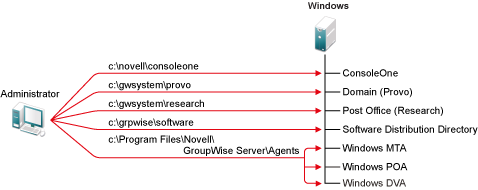3.2 Planning a Basic GroupWise System
The GroupWise Installation program helps you install the GroupWise software to the appropriate locations and helps you create and configure your basic GroupWise system (primary domain, post office, and agents).
If you are comfortable with your knowledge of GroupWise, you can skip this planning section and continue with Section 3.3, Setting Up a Basic GroupWise System. Otherwise, you should use the Basic GroupWise System Worksheet to record your decisions about how to set up your basic GroupWise system. The topics in this section present the required information in a convenient planning sequence. The Installation Worksheet organizes the information in the order in which you need it during installation and setup.
For additional assistance in planning your GroupWise installation, visit the GroupWise Best Practice Wiki.
IMPORTANT:If you plan to install GroupWise in a clustered server environment, refer to the GroupWise 2012 Interoperability Guide as you plan your GroupWise system.
3.2.1 Determining Installation Locations
The GroupWise Installation program prompts you for information about the Novell eDirectory tree where you plan to create GroupWise objects and the network server locations where you plan to create GroupWise directories and install software.
Novell eDirectory
GroupWise is administered through eDirectory, the directory service provided by Novell. All components, such as domains, post offices, libraries, and agents, as well as all users’ GroupWise accounts, are configured through objects in eDirectory. You need to make sure that you have eDirectory installed in your environment. eDirectory can be installed on Linux or Windows.
GroupWise 2012 includes the Novell eDirectory downloadable ISO image to assist those who do not already have eDirectory installed and want to install it on Linux or Windows. Follow the instructions in the Novell eDirectory Installation Guide to install eDirectory, along with its latest Support Pack, before proceeding to install your basic GroupWise system.
eDirectory Tree Access
In order to access the eDirectory tree, the GroupWise Installation program needs the IP address or DNS hostname of a server where a replica of the tree can be found. It also needs an eDirectory user name with Admin-equivalent rights, the password for the user name, and the eDirectory context where the User object can be found. Some parts of the installation process require LDAP authentication to eDirectory, so LDAP must be enabled on your eDirectory server.
The GroupWise Installation program must extend the schema of the eDirectory tree where you plan to create your GroupWise system. Because all objects for a single GroupWise domain must reside in the same eDirectory tree, installing a basic system (one domain) requires you to extend one tree only.
|
BASIC GROUPWISE SYSTEM WORKSHEET |
|---|
|
Under , specify the IP address or DNS hostname of a server where a replica of the eDirectory tree resides. Also provide the authentication information so that the GroupWise Installation program can access the eDirectory tree and extend the schema. |
User Objects in eDirectory
You must make sure all users who will use GroupWise exist in eDirectory. GroupWise accounts can only be assigned to eDirectory User objects and GroupWise External Entity objects.
NOTE:GroupWise external entities represent non-eDirectory users and are added to eDirectory for the sole purpose of assigning GroupWise accounts to these users. GroupWise external entities require GroupWise licenses but not eDirectory licenses. You can add GroupWise external entities only after you have installed GroupWise.
ConsoleOne
GroupWise administration is performed through ConsoleOne, using the version listed in Section 2.1, GroupWise Administration Requirements. When you install GroupWise, the GroupWise Administrator snap-ins are copied into an existing ConsoleOne installation. The GroupWise Administrator snap-ins extend the functionality of ConsoleOne to let you administer GroupWise. ConsoleOne considerations differ by platform:
|
Linux: |
For a GroupWise system on Linux, ConsoleOne must already be installed before you set up your GroupWise system. For your convenience, ConsoleOne is included in the downloaded GroupWise 2012 software image in the consoleone/Linux subdirectory. To install ConsoleOne, run c1‑install. At a later time, you can install ConsoleOne to additional Linux locations. The required ConsoleOne installation directory is: /usr/ConsoleOne |
|
Windows: |
For a GroupWise system on Windows, you need to decide which ConsoleOne location you want to use to administer GroupWise. This can be a ConsoleOne location on a network server, such as where domains and post offices are located, or it can be on a local workstation. If you plan to use ConsoleOne on a local workstation, you need to perform the ConsoleOne installation from that workstation. For your convenience, ConsoleOne is included in the downloaded GroupWise 2012 software image. The GroupWise Installation program lets you install ConsoleOne if necessary. You can also use the GroupWise Installation program at a later time to install ConsoleOne and the GroupWise Administrator snap-ins to additional locations. The default ConsoleOne installation directory is: drive:\Novell\ConsoleOne |
|
BASIC GROUPWISE SYSTEM WORKSHEET |
|---|
|
Under , specify the path for the ConsoleOne location you want to use to administer GroupWise. |
For more information about ConsoleOne, see ConsoleOne Administration Tool
in System
in the GroupWise 2012 Administration Guide.
GroupWise Software Distribution Directory
During installation, you are prompted to create a GroupWise software distribution directory on a network server and then copy selected GroupWise software components to the directory.
You should consider the following when deciding where to create the software distribution directory:
Disk Space Required for the Software
The disk space required for the directory depends on which software components you copy to the directory. The maximum disk space required to store all the GroupWise software components for one language is approximately 800 MB. For a breakdown by component, see Section 2.1, GroupWise Administration Requirements.
We recommend that you copy at least the GroupWise client files to the directory. This enables users to install the GroupWise client from the distribution directory. Otherwise, you need to mount the downloaded GroupWise 2012 software image as a network volume or file system, unless you use one of the software distribution methods described in Distributing the GroupWise Windows Client
in Client
in the GroupWise 2012 Administration Guide.
NOTE:On Linux, you should install the GroupWise Administration component to your software distribution directory. It includes the RPMs for GroupWise Check (GWCheck) and the GroupWise Database Copy utility (DBCopy). These RPMs are not installed by the GroupWise Installation program. For more information about these utilities, see Stand-Alone Database Maintenance Programs
in Databases
in the GroupWise 2012 Administration Guide.
Default Software Distribution Directory Location
The default location for the software distribution directory varies by platform:
|
Linux: |
/opt/novell/groupwise/software |
|
Windows: |
drive:\grpwise\software |
|
BASIC GROUPWISE SYSTEM WORKSHEET |
|---|
|
Under , specify the path for the software distribution directory. Under , mark the software components that you want to copy there. |
The GroupWise Installation program lets you create one software distribution directory. After you set up your basic GroupWise system, you can create additional software distribution directories if needed. For more information, see Software Directory Management
in System
in the GroupWise 2012 Administration Guide.
Agent Platform
The Message Transfer Agent (MTA), the Post Office Agent (POA), and the Document Viewer Agent (DVA) are available as Linux executables and Windows executables. Plan to create domains and post offices on the same platform and server where you plan to install the agents.
|
BASIC GROUPWISE SYSTEM WORKSHEET |
|---|
|
Under , specify the type of agents (Linux or Windows) you want to use. |
3.2.2 Planning Your Primary Domain
The primary domain functions as the main administration unit for the GroupWise system. Domains that you create after the first domain are secondary domains.
When you configure GroupWise information in eDirectory, it is also stored in the GroupWise domain database. From the domain database, the GroupWise agents distribute the information to each post office database. Users then get the information, such as user addresses, from the post office database. Domains can be located on Linux and Windows servers.
In a multiple-post-office system, the domain also organizes post offices into a logical grouping for addressing and routing purposes, and enables you to scale your GroupWise system to meet your current and future needs.
As you create your basic GroupWise system, the Installation program prompts you for information about the primary domain.
System and Domain Names
Each domain requires a unique name. The name is used as the Domain object’s name in eDirectory. It is also used for addressing and routing purposes within GroupWise, and can appear in the GroupWise Address Book. The domain name can reflect a location, company name or branch name, or some other element that makes sense for your organization. For example, you might want the domain name to be the location (such as Provo) while the post office name is one of the company’s departments (such as Research).
A domain name should consist of a single string. Use underscores (_) rather than spaces as separators between words to facilitate addressing across the Internet.
Do not use any of the characters listed below in system and domain names:
|
ASCII characters 0-31 |
Comma , |
|
Asterisk * |
Double quote " |
|
At sign @ |
Extended ASCII characters that are graphical or typographical symbols; accented characters in the extended range can be used |
|
Braces { } |
Parentheses ( ) |
|
Colon : |
Period . |
IMPORTANT:Name your domain carefully. After it is created, the name cannot be changed.
You must also provide a name for your GroupWise system. The system name is used when connecting to other GroupWise systems; for this reason, it must be different than any other GroupWise system with which you might want to connect. The system name can be your company name (for example, Novell), GroupWise, or anything else that fits the naming scheme you want to use. The system name is displayed only in ConsoleOne so any characters can be used. You cannot change the name after your system is created.
|
BASIC GROUPWISE SYSTEM WORKSHEET |
|---|
|
Under , specify the name of the GroupWise system that you want to create in eDirectory. Under , specify the domain name. |
Domain Directory
The domain requires a directory structure in which to store database files and temporary files that are created during message routing. As you choose a location for the domain directory, consider the following:
Domain Security
GroupWise users never need access to the domain directory, so you should create it in a location that you can easily secure.
Server Platform and Version
The domain directory can be located on any of the supported platforms listed in Section 2.1, GroupWise Administration Requirements.
MTA Access
The MTA requires direct access to the domain directory so that it can write to the domain database (wpdomain.db). Therefore, you might want to consider the server type (Linux or Windows) and location (local or remote) of the MTA before deciding on a domain directory. For information about the MTA, see Section 3.2.4, Planning Your GroupWise Agents. For examples of possible domain directory locations and MTA configurations, see Sample GroupWise Configurations.
IMPORTANT:On Linux, the MTA must be installed on the same server where its directory structure is located. A file system mount between Linux servers does not provide the necessary file locking mechanisms for the GroupWise Linux MTA to write to the domain database on a remote Linux server.
Domain Disk Space Requirements
The domain directory requires a minimum of 100-200 MB of disk space for the domain database. In addition, you should plan for an additional 1 GB or more of free disk space for the temporary storage of messages when links are down.
For additional guidance, visit the GroupWise Best Practices Wiki.
Domain Directory Name
You should specify an empty directory for the domain. If you want, the directory can reflect the domain name you chose. Use the following platform-specific conventions:
|
Linux: |
Use only lowercase characters. |
|
Windows: |
No limitations. |
Choose the name and path carefully. After the directory is created, it is difficult to rename.
|
BASIC GROUPWISE SYSTEM WORKSHEET |
|---|
|
Under , specify the full path for the domain directory. |
IMPORTANT:The installation process proceeds more smoothly if you create the domain directory in advance.
Domain Context
You can create the Domain object in any Organization or Organizational Unit container in any context in your eDirectory tree. The only requirement is that it be in the same tree as the other objects associated with the domain (Post Office object, User objects, and so on).
The following sections provide examples of where you might place your Domain object. Because it is helpful to discuss the Domain object’s context in relationship to the Post Office object’s context, the examples also include context information for the Post Office object.
Objects in the Same Container as Users’ Organizational Units
In the following example, the Domain object (Provo) and Post Office object (Research) reside in the same container (Provo) as the organizational units (Accounting, Manufacturing, R&D, and Sales) that contain the users. This allows you to associate the domain with a single organization and associate one post office with all users within the organization.
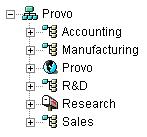
Objects Mirror eDirectory Organization
The following example is similar to the previous example, except that a separate post office is created for each organizational unit that contains users. The Domain object (Provo) resides in the organization (Provo) and the Post Office objects reside in the same organizational units (Accounting, Manufacturing, R&D, and Sales) as the users.
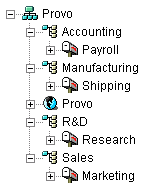
As in the previous example, this organizational structure allows you to quickly associate users with their post offices. In addition, if you have thousands of users split between the different organizational units, this method allows you to create multiple post offices with a smaller number of users on each post office.
Objects Mirror Network Server Organization
Because the domain and post office have directory structures on network servers, you could also choose to place the Domain and Post Office objects in the same context as the servers where the directories will reside, as shown in the following example.
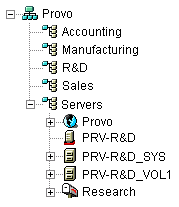
Objects in a Dedicated Container
If, rather than mirroring your eDirectory or server organization, you prefer to keep all your GroupWise objects together, you could create a container, such as GroupWise, and place all GroupWise objects in that container, as shown below.
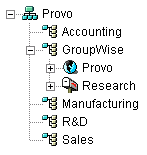
Administratively, this type of organizational structure makes it easier to restrict a GroupWise administrator’s object and property rights to GroupWise objects only.
For information about GroupWise administrator rights, see GroupWise Administrator Rights
in Security Administration
in the GroupWise 2012 Administration Guide.
|
BASIC GROUPWISE SYSTEM WORKSHEET |
|---|
|
Under , specify the context where you want to create the Domain object. |
IMPORTANT:If the context does not already exist in your eDirectory tree, create the context now.
The GroupWise View in ConsoleOne
ConsoleOne includes a GroupWise View, displayed under the GroupWise System container.
The GroupWise View filters out all non-GroupWise objects and shows how GroupWise objects relate to each other. For example, in the left pane, notice the Post Office object (Development) is subordinate to the Domain object (Provo1). You can select an object in the left pane and display its associated objects (User, Resource, and so on) in the right pane.
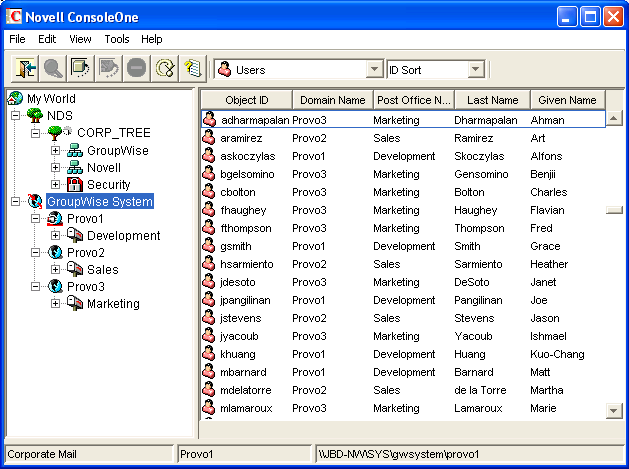
The GroupWise View is particularly useful if your GroupWise objects are placed in different contexts in the eDirectory tree. Rather than searching for GroupWise objects throughout the tree, you can administer the objects from the GroupWise View.
Some GroupWise administrative functions can only be done in the GroupWise View. This includes such tasks as defining users from other GroupWise systems so that they appear in your system’s GroupWise Address Book.
For more information about the GroupWise View, see GroupWise View
in System
in the GroupWise 2012 Administration Guide.
Domain Language
The domain language determines the sort order for items in the GroupWise Address Book.
NOTE:The list of languages displayed in ConsoleOne includes more languages than GroupWise supports. See Multilingual GroupWise Systems
in System
in the GroupWise 2012 Administration Guide for a list of valid domain languages.
|
BASIC GROUPWISE SYSTEM WORKSHEET |
|---|
|
Under , specify the language for the domain. The domain language becomes the default language for the domain’s post offices. |
Domain Time Zone
When a message is sent from a user in one time zone to a user in another time zone, GroupWise adjusts the message’s time so that it is correct for the recipient’s time zone. For example, if a user in New York (GMT -05:00, Eastern Time) schedules a user in Los Angeles (GMT -08:00, Pacific Time) for a conference call at 4:00 p.m. Eastern Time, the appointment is scheduled in the Los Angeles user’s calendar at 1:00 p.m. Pacific Time.
|
BASIC GROUPWISE SYSTEM WORKSHEET |
|---|
|
Under , specify the time zone for the domain. The domain time zone becomes the default time zone for the domain’s post offices. |
3.2.3 Planning Your Post Office
The post office contains users’ mailboxes. Like a domain, a post office requires a name, has a directory structure and an eDirectory object, and can be configured to support different languages and time zones. Post offices can be located on Linux and Windows servers.
The following sections prepare you to supply the GroupWise Installation program with the required information.
Post Office Name
The post office, like the domain, requires a unique name. The name is used as the Post Office object’s name in eDirectory. It is also used for addressing and routing purposes within GroupWise, and can appear in the GroupWise Address Book. The post office name can reflect any element that makes sense for your organization. For example, you might want the domain name to be the location (such as Provo) while the post office name is one of the company’s departments (such as Research).
Post office names must be a single string. Use underscores (_) rather than spaces as separators between words to facilitate addressing across the Internet. The same characters that are invalid in domain names are also invalid in post office names (see System and Domain Names).
IMPORTANT:Name your post office carefully. After it is created, the name cannot be changed.
|
BASIC GROUPWISE SYSTEM WORKSHEET |
|---|
|
Under , specify the name you have selected. |
Post Office Directory
The post office requires a directory structure in which to store database files and temporary files that are created during message routing and delivery. As you choose a location for the post office directory, consider the following:
Post Office Security
The GroupWise Windows client accesses the post office through a client/server (TCP/IP) connection to the Post Office Agent (POA). GroupWise WebAccess uses an HTTP connection through a Web server. Therefore, GroupWise users never need access to the post office directory, so you should create the directory in a location that you can easily secure.
Server Platform and Version
The post office directory can be located on any of the supported platforms listed in Section 2.1, GroupWise Administration Requirements.
POA Access
The POA requires direct access to the post office directory so that it can write to the post office database (wphost.db). Therefore, the POA must be installed on the same server where its directory structure is located.
Post Office Disk Space Requirements
The post office directory holds users’ messages and attachments, so you should plan a minimum of 5 MB per user. 100 MB or more per user is recommended. Although actual messages are relatively small, message attachments (documents, spreadsheets, images, and so on) can greatly increase the amount of disk space used.
Using ConsoleOne, you can restrict the amount of disk space users are allowed for their mailboxes. When you know the number of users and the amount of disk space allocated to each user, you can more accurately determine the amount of disk space required for the post office.
You can reduce the amount of disk space required for the post office by forcing users to run the GroupWise Windows clients in Caching mode rather than Online mode. In Online mode, messages are stored only in the post office. In Caching mode, messages are also stored on users’ local drives, so you can reduce the size of users’ Online mailboxes independent of what users want to store in personal locations.
In addition to user messages and attachments, the post office directory also contains a document library. If you want to use GroupWise document management, you should take into account the disk space you want to provide for storing documents.
Plan for 100-300 MB for the post office database, which holds the GroupWise Address Book and updates to it for download by Remote client users. Also plan 500 MB or more for the temporary storage of messages when links are down.
Post Office Directory Name
You should specify an empty directory for the post office. If you want, the directory can reflect the post office name you chose. Use the following platform-specific conventions:
|
Linux: |
Use only lowercase characters. |
|
Windows: |
No limitations. |
Choose the name and path carefully. After the directory is created, it is difficult to rename. If the directory you specify does not exist, it is created during installation.
|
BASIC GROUPWISE SYSTEM WORKSHEET |
|---|
|
Under , specify the full path for the post office directory. |
IMPORTANT:The installation process proceeds more smoothly if you create the post office directory in advance.
Post Office Context
Like the Domain object, you can create the Post Office object in any Organization or Organizational Unit container in any context in your eDirectory tree. The only requirement is that it be in the same tree as the Domain object and other objects associated with the domain (User objects and so on). For configuration examples, see Domain Context.
|
BASIC GROUPWISE SYSTEM WORKSHEET |
|---|
|
Under , specify the context where you want to create the Post Office object. |
IMPORTANT:If the context does not already exist in your eDirectory tree, create the context now.
Post Office Language
The post office language determines the sort order for items in the GroupWise Address Book.
NOTE:The list of languages displayed in ConsoleOne includes more languages than GroupWise supports. See Multilingual GroupWise Systems
in System
in the GroupWise 2012 Administration Guide for a list of valid post office languages.
The post office assumes the same language as its domain unless you specify otherwise. For example, if you set the domain and post office language to English, the GroupWise Address Book items are sorted according to English sort order rules. This is true even if some users in the post office are running non-English GroupWise clients such as German or Japanese. Their client interface and Help files are in German or Japanese, but the sort order in the GroupWise Address Book is according to English standards. Time, date, and number formats for the non-English clients default to the workstation language.
|
BASIC GROUPWISE SYSTEM WORKSHEET |
|---|
|
Under , specify the language for the post office. |
Post Office Time Zone
When a message is sent from a user in one time zone to a user in another time zone, GroupWise adjusts the message’s time so that it is correct for the recipient’s time zone. For example, if a user in New York (GMT -05:00, Eastern Time) schedules a user in Los Angeles (GMT -08:00, Pacific Time) for a conference call at 4:00 p.m. Eastern Time, the appointment is scheduled in the Los Angeles user’s calendar at 1:00 p.m. Pacific Time.
The post office assumes the same time zone as its domain unless you specify otherwise.
|
BASIC GROUPWISE SYSTEM WORKSHEET |
|---|
|
Under , specify the time zone where the post office is located. |
3.2.4 Planning Your GroupWise Agents
The Message Transfer Agent (MTA) and Post Office Agent (POA) route messages through the GroupWise system. The MTA handles all message traffic between the domain and post office, while the POA handles all message traffic within the post office. The Document Viewer Agent (DVA) converts attached document files into HTML for viewing in GroupWise WebAccess and for indexing by the POA, if it has been configured to use it. The GroupWise agents can run on Linux and Windows servers.
-
Message Transfer Agent: GroupWise requires one MTA per domain, which means that you need to install and run one MTA for your basic GroupWise system.
In addition to routing user messages between post offices and between domains, the MTA routes administration messages from the domain to the post office. For example, when a user is given a GroupWise account in eDirectory, the user is added to the GroupWise domain database. At the same time, the MTA routes an administration message from the domain to the post office so that the POA can add the user to the post office database. After the user is added to the post office database, the post office’s users can see the newly added user’s information in the GroupWise Address Book
-
Post Office Agent: GroupWise requires one POA per post office, which means that you need to install and run one POA for your basic GroupWise system.
The POA routes messages within the post office, updates the post office database when it receives administration messages from the MTA, and performs other maintenance tasks in the post office.
-
Document Viewer Agent: GroupWise requires at least one DVA. It is automatically installed along with the MTA and the POA.
The DVA can simultaneously convert multiple document files into HTML format. If it encounters a problem converting a particular document file, the problem does not affect conversion of other document files, nor does the problem document file affect the functioning of WebAccess or of the POA.
The following sections prepare you to supply the information required when installing the MTA and POA:
Agent Location
The MTA requires direct access to the domain directory so that it can write to the domain database. The POA requires direct access to the post office directory so that it can write to the post office database. The DVA does not require direct access to any directory, because it communicates with the POA through TCP/IP.
Install the MTA and the POA on the same server as its directory. For example, you would install the MTA on the same server as the domain directory and the POA on the same server as the post office directory. This ensures that the agent always has access to its directory.
IMPORTANT:For Linux, this is required, because file system mounts between Linux servers do not provide the necessary file locking mechanisms for the GroupWise Linux agents to access their databases on remote Linux servers. For Windows, other configurations are possible after installation of your basic GroupWise system, but are not recommended.
Consider these platform-specific guidelines:
|
Linux: |
The Linux agents are automatically installed to /opt/novell/groupwise/agents. On Linux, do not move the agent software to a different location. |
|
Windows: |
The default installation directory is c:\Program Files\Novell\GroupWise Server\Agents. However, you can install the agents to any directory you want. |
|
BASIC GROUPWISE SYSTEM WORKSHEET |
|---|
|
Under for your software platform, specify the installation path for the agents. |
POA Configuration
In order to configure the POA, you need to know the IP address or DNS hostname of the server where you plan to install the POA. The POA uses its client/server port to communicate with GroupWise clients; the default client/server port is 1677. The POA uses its message transfer port to communicate with the MTA; the default message transfer port is 7101. Use these default port numbers unless they are already in use by another program on the server where you plan to install the POA.
|
BASIC GROUPWISE SYSTEM WORKSHEET |
|---|
|
Under , specify the IP address or DNS hostname of the POA’s server, along with the required port numbers. |
For a complete list of default port numbers used by the GroupWise agents, refer to GroupWise Port Numbers
in the Appendixes.
MTA Link to the Post Office
To route user and administration messages to the post office, the MTA requires a TCP/IP connection with the post office’s POA. The MTA uses its message transfer port to communicate with the POA; the default message transfer port is 7100. Use this default port number unless it is already in use by another program on the server where you plan to install the MTA.
|
BASIC GROUPWISE SYSTEM WORKSHEET |
|---|
|
Under , specify the IP address or DNS hostname of the MTA’s server, along with the required port number. |
For a complete list of default port numbers used by the GroupWise agents, refer to GroupWise Port Numbers
in the GroupWise 2012 Administration Guide.
Agent Server Consoles and Web Consoles
The MTA, the POA, and the DVA provide agent server consoles to let you monitor and, for the MTA and the POA, reconfigure the agents while at the agent servers for the current agent session. The availability of agent server consoles varies by platform.
|
Linux: |
The MTA and POA server consoles are displayed only if you start the agents with the ‑‑show startup switch on the command line or if you use the show = yes option in the GroupWise High Availability service configuration file (gwha.conf) to cause the grpwise script to start the agents with server consoles.For more information, see Configuring the GroupWise High Availability Service in the gwha.conf File. The DVA does not have a server console on Linux. |
|
Windows: |
The MTA and POA server consoles are displayed if you run the agents as applications but are not displayed if you run the agents as services. The DVA displays a console message window, but not a full server console. |
When the agent server consoles are not available, you can monitor and configure the agents through a Web browser. This feature, referred to as the agent Web console, lets you access the agents’ statistics and diagnostic information from any location where you are connected to the Internet and have access to a Web browser.
By default, the MTA Web console is enabled on port 7180, the POA Web console is enabled on port 7181, and the DVA Web console is enabled on port 8301. Use these default port numbers unless they are already in use by another program on the server where you plan to install the agents.
In your browser, you access the agent Web consoles using the following URLs:
- http://agent_network_address:port
where agent_network_address is the agent’s IP addresses or DNS hostnames and port is the agent’s Web console HTTP port number.
|
BASIC GROUPWISE SYSTEM WORKSHEET |
|---|
|
Under , specify the POA’s HTTP port number. Under , specify the MTA’s HTTP port number. Under , specify the DVA’s HTTP port number. |
For a complete list of default port numbers used by the GroupWise agents, refer to GroupWise Port Numbers
in the GroupWise 2012 Administration Guide.
Linux Installation Options: Automatic Startup, Document View Agent Configuration, and Linux Mount Directory
If you are installing the GroupWise agents on Linux, you have the following additional installation options:
Automatic Startup
The Linux GroupWise agents are Run Control compliant. The Installation program creates symbolic links to the /etc/init.d/grpwise script in the rc3.d and rc5.d directories so that the agents can load on restart into run level 3 or 5, depending on the configuration of your Linux server.
If you want to configure the agents for high availability, as described in Enabling the GroupWise High Availability Service for the Linux GroupWise Agents, they must be configured to start automatically on system startup.
|
BASIC GROUPWISE SYSTEM WORKSHEET |
|---|
|
Under , mark whether or not you want to configure the GroupWise Linux agents to start automatically. |
Enable Document Viewer Agent
The Document Viewer Agent is configured for high availability independently from the POA and the MTA.
|
BASIC GROUPWISE SYSTEM WORKSHEET |
|---|
|
Under , mark whether or not you want to configure the Linux Document Viewer gent to start automatically. |
Linux Mount Directory
Typically, Linux servers and workstations use /mnt for the mount directory. In the future as your GroupWise system grows, the Linux mount directory helps ConsoleOne resolve the UNC paths of GroupWise domain database locations into Linux paths. Although the mount directory information is not used when you are creating your basic GroupWise system, it is gathered at this time for later reference.
GroupWise domains and their associated databases can be located on Linux servers or Windows servers. In the Linux mount directory, you will eventually create mount points that have the same names as the servers that are mounted to those mount points. You will need to do this for each server where a domain is located that you want to access from ConsoleOne on Linux. When you are ready to expand your basic GroupWise system to additional servers, see ConsoleOne on Linux
and ConsoleOne in a Multiple-Platform Environment
in System
in the GroupWise 2012 Administration Guide.
The following table illustrates the correspondence between UNC paths and Linux mount points for GroupWise database locations on Linux servers and on Windows servers, assuming the typical Linux mount directory of /mnt:
|
Platform |
GroupWise Domain UNC Path |
Corresponding Linux Mount Point |
|---|---|---|
|
Linux: |
\\lnx_server\gw_partition_or_directory\ domain_directory |
/mnt/lnx_server/ gw_partition_or_directory |
|
Windows: |
\\windows_server\gw_share\ domain_directory |
/mnt/windows_server/ gw_share |
IMPORTANT:Although Windows is not a case-sensitive operating system, the case of characters in path names becomes significant when the directory structure is mounted to a Linux machine.
|
BASIC GROUPWISE SYSTEM WORKSHEET |
|---|
|
Under , specify a different directory if you do not want to use the default /mnt directory. |
Windows Installation Options: SNMP Traps and Service versus Application
If you are installing the GroupWise agents on Windows, you have the following additional installation options:
SNMP Services
If you want the GroupWise agents to be able to communicate with SNMP management and monitoring programs, you must configure them for this functionality during installation. The Windows SNMP service must already be enabled on the Windows server in order to configure this functionality for the GroupWise agents.
|
BASIC GROUPWISE SYSTEM WORKSHEET |
|---|
|
Under , mark whether you want to configure the GroupWise agents to communicate with SNMP management and monitoring programs. If you do, ensure that the Windows SNMP service is enabled on the GroupWise agent server. |
For more information about SNMP, see the following sections in the GroupWise 2012 Administration Guide:
Service versus Application
You can run the Windows MTA, POA, and DVA as Windows services or applications.
|
BASIC GROUPWISE SYSTEM WORKSHEET |
|---|
|
Under , mark whether you want to run the GroupWise agents as Windows services. |
When you run the agents as Windows services, they must run under a specific user account. The user account you use depends on where the domain and post office directories are located:
-
When the domain and post office directories are located on the same server where you are installing the agents, the agents can run under the local system account and no password is required.
When the agents run under the local system account, you can enable them to display the agent server consoles on the server desktop on Windows Server 2003. This interaction with the desktop is not available on Windows Server 2008 and later Windows versions.
-
When the domain and post office directories are located on a remote Windows server, you must specify a user with rights to access the domain and post office directories, along with the user’s associated password.
-
For the DVA, the user account depends on the location of the DVA home directory, as described in
Setting the DVA Home Directory
inDocument Viewer Agent
in the GroupWise 2012 Administration Guide.
IMPORTANT:For simplicity of agent administration, running the GroupWise agents as the Windows Administrator user is highly recommended.
As with all Windows services, you can start the agents manually or have them start automatically each time the Windows server restarts.
|
BASIC GROUPWISE SYSTEM WORKSHEET |
|---|
|
Under , record the Windows user account that the agent services will run under, and if necessary, the password for the account. If you are using the local system account, indicate whether you want to allow the agent services to interact with the desktop to display the agent server consoles. Select whether you want the agent services to start automatically or manually. |
3.2.5 Sample GroupWise Configurations
Many different configurations are possible for your GroupWise system after you create your basic GroupWise system. The following diagrams illustrate a basic GroupWise system (primary domain and one post office) on Linux and Windows.
Linux Server
The following diagram shows all GroupWise components on a Linux server.
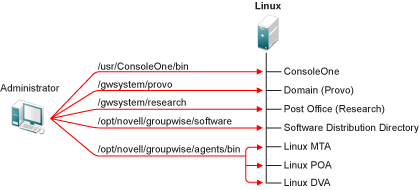
Windows Server
The following diagram shows all GroupWise components on a Windows server.
